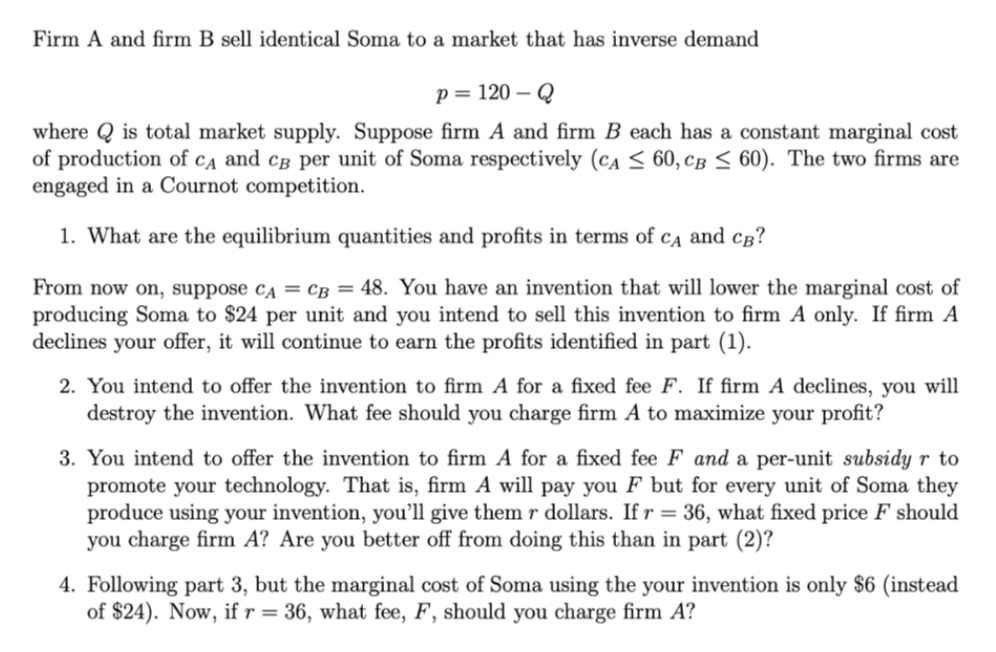Firm A and firm B sell identical Soma to a market that has inverse demand p= 120 – Q where Q is total market supply. Suppose firm A and firm B each has a constant marginal cost of production of CA and cB per unit of Soma respectively (CA S 60, CB < 60). The two firms are engaged in a Cournot competition.
Firm A and firm B sell identical Soma to a market that has inverse demand p= 120 – Q where Q is total market supply. Suppose firm A and firm B each has a constant marginal cost of production of CA and cB per unit of Soma respectively (CA S 60, CB < 60). The two firms are engaged in a Cournot competition.
Chapter15: Imperfect Competition
Section: Chapter Questions
Problem 15.3P
Related questions
Question
1

Transcribed Image Text:Firm A and firm B sell identical Soma to a market that has inverse demand
p = 120 – Q
where Q is total market supply. Suppose firm A and firm B each has a constant marginal cost
of production of ca and câ per unit of Soma respectively (ca < 60, CB < 60). The two firms are
engaged in a Cournot competition.
1. What are the equilibrium quantities and profits in terms of cĄ and cg?
From now on, suppose ca = cB = 48. You have an invention that will lower the marginal cost of
producing Soma to $24 per unit and you intend to sell this invention to firm A only. If firm A
declines your offer, it will continue to earn the profits identified in part (1).
2. You intend to offer the invention to firm A for a fixed fee F. If firm A declines, you will
destroy the invention. What fee should you charge firm A to maximize your profit?
3. You intend to offer the invention to firm A for a fixed fee F and a per-unit subsidy r to
promote your technology. That is, firm A will pay you F but for every unit of Soma they
produce using your invention, you’ll give them r dollars. If r = 36, what fixed price F should
you charge firm A? Are you better off from doing this than in part (2)?
4. Following part 3, but the marginal cost of Soma using the your invention is only $6 (instead
of $24). Now, if r = 36, what fee, F, should you charge firm A?
Expert Solution
This question has been solved!
Explore an expertly crafted, step-by-step solution for a thorough understanding of key concepts.
Step by step
Solved in 5 steps

Knowledge Booster
Learn more about
Need a deep-dive on the concept behind this application? Look no further. Learn more about this topic, economics and related others by exploring similar questions and additional content below.Recommended textbooks for you


Economics: Private and Public Choice (MindTap Cou…
Economics
ISBN:
9781305506725
Author:
James D. Gwartney, Richard L. Stroup, Russell S. Sobel, David A. Macpherson
Publisher:
Cengage Learning

Microeconomics: Private and Public Choice (MindTa…
Economics
ISBN:
9781305506893
Author:
James D. Gwartney, Richard L. Stroup, Russell S. Sobel, David A. Macpherson
Publisher:
Cengage Learning


Economics: Private and Public Choice (MindTap Cou…
Economics
ISBN:
9781305506725
Author:
James D. Gwartney, Richard L. Stroup, Russell S. Sobel, David A. Macpherson
Publisher:
Cengage Learning

Microeconomics: Private and Public Choice (MindTa…
Economics
ISBN:
9781305506893
Author:
James D. Gwartney, Richard L. Stroup, Russell S. Sobel, David A. Macpherson
Publisher:
Cengage Learning